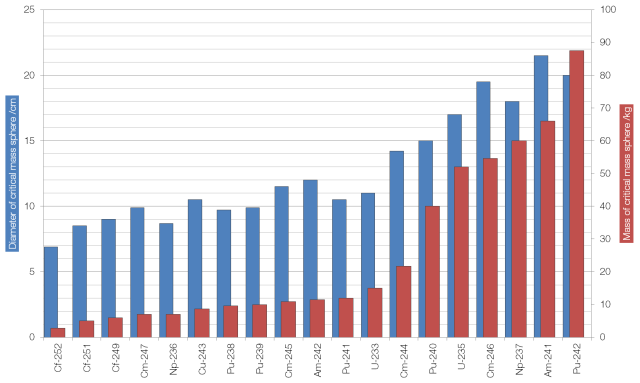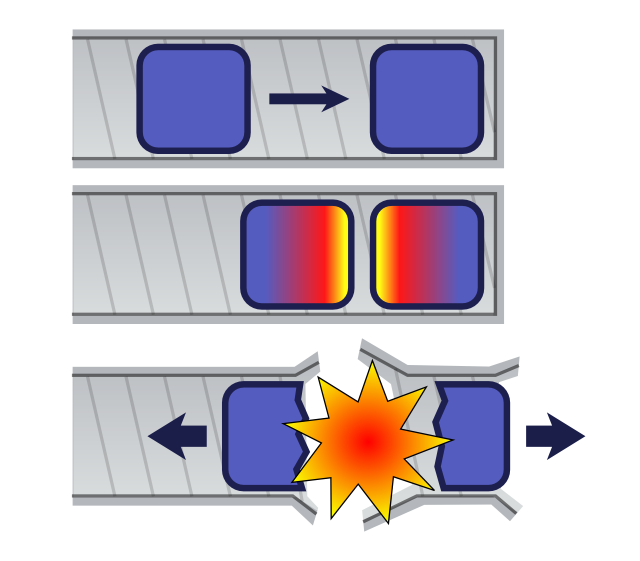When a nuclear weapon is detonated at high altitude the effects are very different to those created by a low-altitude detonation. Aside from creating a much larger, much faster-expanding fireball, the nuclear detonation also creates an electromagnetic pulse (EMP) that can damage electromagnetic equipment on the ground.
A nuclear EMP differs from other EMPs such as those generated by lightning strikes or by conventional EMP weapons (such as flux compression generators) in that it is much more powerful* and is composed of three different pulses called E1, E2 and E3.
E1
The E1 pulse is the most destructive, occurring far too quickly for protective equipment to activate. It is the component that destroys computers and communications lines by causing the insulating components of these devices to become conducting and allowing electrical current to flow between regions that are not supposed to be connected, effectively short-circuiting all circuits simultaneously.
The E1 pulse is created when the intense gamma radiation from the nuclear detonation ionises atoms in the upper atmosphere (Compton scattering); releasing electrons which travel downward at relativistic speeds, about 95% of the speed of light. Any charged particle in a magnetic field will experience a force (the motor effect) and the Earth’s magnetic field causes the electrons liberated by the gamma radiation to follow a spiral path around the magnetic field lines. As the electron oscillates back and forth it creates an electromagnetic field and as there are about 1025 electrons doing this simultaneously, this creates a very powerful (about 50000 volts per metre, 6.6 megawatts per square metre) but very short-lived electromagnetic pulse. The E1 pulse typically reaches its peak value in about five billionths of a second (five nanoseconds) and ends after about one millionth of a second (one microsecond) as the scattered electrons are stopped by collisions with air molecules.
The shape of the region affected by the E1 pulse depends on latitude, due to the changing orientation of the Earth’s magnetic field. Away from the equator the region is U-shaped, and towards the equator it is more symmetrical.
E2
The E2 component is caused, like E1, by Compton scattering when scattered gamma rays, gamma rays produced by interaction of fission neutrons with atoms in the air and gamma rays produced by radioactive decay of fission fragments ionise air particles.
The E2 component lasts from about one microsecond after detonation to one second after detonation and is very similar to the pulses created by lightning strikes. The E2 component is easy to protect against using conventional lightning protection equipment, but this protective equipment is likely to have been damaged by the E1 component and will therefore not function correctly, allowing the E2 component to cause further widespread damage.
E3
The E3 component is very different to the E1 and E2 components. It lasts tens to hundreds of seconds and is caused when the Earth’s magnetic field “snaps” back into place after being pushed out of the way by the ionised plasma created by the expanding nuclear fireball. This induces electrical currents in conductors on the ground such as pipelines, power lines and transformers.
The E3 component is similar to the pulse created by a geomagnetic storm, when a severe (X-class) solar flare pushes on the Earth’s magnetosphere and is sometimes referred to as “Solar EMP”. In 1989 a solar EMP-type event caused the collapse of the Hydro-Québec power grid when a huge coronal mass ejection followed a X15-class solar flare.
* During a Soviet nuclear EMP test called K-3 the E3 component of the pulse fused the entire length of a 570-kilometre overhead telephone line (with currents reaching up to 3400 amperes) and the E1 component caused all of the attached overvoltage protectors to fire. The test also started a fire that caused the Karaganda power station to burn down and penetrated nearly a metre into the Earth to burn out 1000 km of buried power cables.




